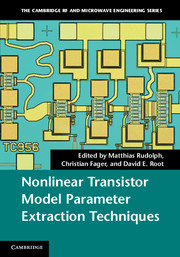Book contents
- Frontmatter
- Contents
- List of contributors
- Preface
- 1 Introduction
- 2 DC and thermal modeling: III–V FETs and HBTs
- 3 Extrinsic parameter and parasitic elements in III–V HBT and HEMT modeling
- 4 Uncertainties in small-signal equivalent circuit modeling
- 5 The large-signal model: theoretical foundations, practical considerations, and recent trends
- 6 Large and packaged transistors
- 7 Nonlinear characterization and modeling of dispersive effects in high-frequency power transistors
- 8 Optimizing microwave measurements for model construction and validation
- 9 Practical statistical simulation for efficient circuit design
- 10 Noise modeling
- Index
- References
8 - Optimizing microwave measurements for model construction and validation
Published online by Cambridge University Press: 25 October 2011
- Frontmatter
- Contents
- List of contributors
- Preface
- 1 Introduction
- 2 DC and thermal modeling: III–V FETs and HBTs
- 3 Extrinsic parameter and parasitic elements in III–V HBT and HEMT modeling
- 4 Uncertainties in small-signal equivalent circuit modeling
- 5 The large-signal model: theoretical foundations, practical considerations, and recent trends
- 6 Large and packaged transistors
- 7 Nonlinear characterization and modeling of dispersive effects in high-frequency power transistors
- 8 Optimizing microwave measurements for model construction and validation
- 9 Practical statistical simulation for efficient circuit design
- 10 Noise modeling
- Index
- References
Summary
Introduction
The process of modeling microwave devices is based on either technology computer aided design (TCAD) simulations or measurements. The former is the basis for the so-called compact models, which is the preferred modeling technique for devices aiming for digital and low-frequency (i.e., not microwave) analog designs. This book focuses on the second technique, namely the use of measurements in the model construction process. This chapter will demonstrate that acquiring measurements for efficient and accurate model construction requires thorough experiment design. This chapter focuses on the use of linear and nonlinear microwave measurements for model construction and – importantly – model validation. Noise measurements are beyond the scope of this chapter, so readers are referred to the dedicated (Chapter 10) on noise modeling.
The chapter starts with a brief review on linear and nonlinear microwave measurements. Subsequently, as on-wafer devices are embedded in a layout structure to enable on-wafer measurements, the effect of pads and access transmission lines should be de-embedded from the measurements. This is an important step, especially in the case of devices on silicon substrates, as an over- or under de-embedding may result in nonphysical device parameter values. Due to differences in the mathematical procedures, linear and nonlinear measurements are discussed separately.
We proceed by explaining issues in collecting linear measurements aimed at device modeling. If the purpose is to extract the bias-dependency of the model parameters, e.g., to advance to a nonlinear model at a later stage, the number of required measurements can easily become extensive, especially in the case of power devices which have a wide operating range.
- Type
- Chapter
- Information
- Nonlinear Transistor Model Parameter Extraction Techniques , pp. 257 - 286Publisher: Cambridge University PressPrint publication year: 2011



